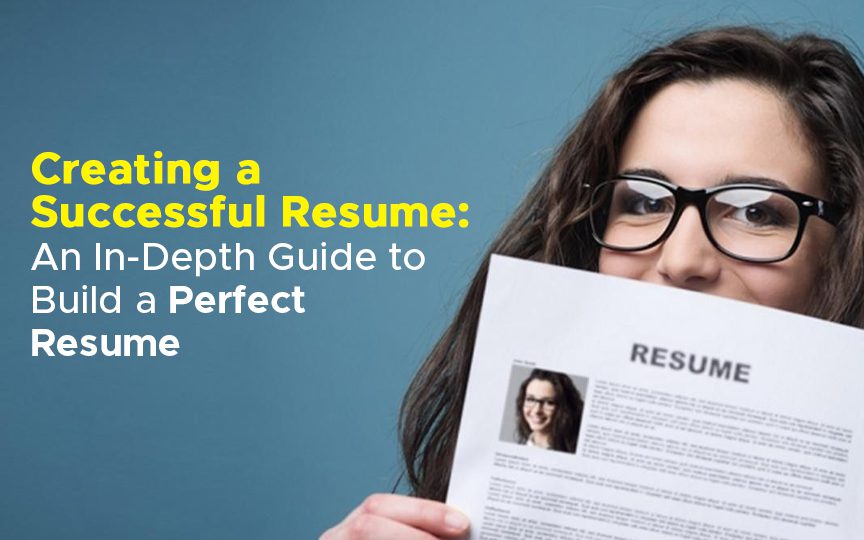A resume, also known as a curriculum vitae (CV), is a concise overview that includes information about your personal background, educational background, prior employment history, soft and technical abilities, and other relevant details. Your resume is emailed to HR or the company when you apply for a job.
The majority of an employer will get their initial impression of you from your CV. Creating an exceptional CV is essential to making an impression in a competitive employment market. An excellent CV must concisely and clearly convey all the relevant information about you as a professional. Both content and format matter.
You should be crystal clear about what you are attempting to say before going into the specifics of resume structure. Additionally, it’s critical to stay focused on the things that the employer finds significant and to make every effort to customize your CV for the position. Building a resume the right way is essential to effectively showcase your skills, experiences, and qualifications to potential employers.
Aim to write your resume with the employer’s perspective in mind. What information do they seek? By responding to this question, you will be able to concentrate on the details that the employer will find important. Consequently, this raises the possibility that you will catch their interest.
Let’s get into this topic in a thorough way to learn more about resume creation and understand the requirements according to the market requirements and the changing demands every day.
Here are some tips and guidelines for creating a strong and compelling resume
Choose the Right Resume Format There are several resume formats, including chronological, functional, and combination (also known as hybrid). Choose the format that best highlights your strengths and is most appropriate for your career stage and goals.
Contact Information Include your full name, phone number, email address, and, if applicable, your LinkedIn profile. Ensure that your contact information is up-to-date and professional.
Write a Strong Summary or Objective Statement: Create a brief, attention-grabbing summary or objective statement at the beginning of your resume. This should provide a snapshot of your career goals and what you can offer to the employer.
Highlight Your Skills: List relevant skills in a dedicated section, including technical, soft, and transferable skills. Tailor this section to match the job requirements.
Work Experience: List your work experiences in reverse chronological order (most recent job first).
Include the company name, job title, dates of employment, and a concise description of your responsibilities and accomplishments.
Use action verbs and quantify your achievements with specific numbers or percentages where possible.
In-depth Educational details Include your educational background, starting with the most recent degree or certification.
Mention the institution, degree earned, major, graduation date, and any honors or relevant coursework.
Additional Sections (Optional): Depending on your background, you may include sections like certifications, awards, publications, volunteer work, or languages spoken.
Tailor Your Resume: Customize your resume for each job application by highlighting the skills and experiences most relevant to the specific position.
Use keywords from the job description to increase your chances of passing through applicant tracking systems (ATS).
Keep it Concise: Aim for a resume length of one page for less experienced candidates and up to two pages for those with extensive experience.
Focus on the most important and relevant information.
Use a Professional Tone: Write in a professional and concise manner, avoiding jargon or slang.
Proofread your resume carefully for spelling, grammar, and formatting errors.
Use a Clean and Readable Design: Choose a clean, easily readable font (e.g., Arial, Calibri, Times New Roman) and maintain a consistent formatting style.
Use bullet points and headers to organize information.
Include Relevant Keywords: Use industry-specific keywords to ensure your resume aligns with the job posting and catches the attention of ATS.
Be Honest: Always provide truthful and accurate information on your resume. Exaggerating or falsifying information can have serious consequences.
Include References: Generally, it’s not necessary to include references on your resume. Instead, you can create a separate document for references and provide them upon request.
Update Regularly: Keep your resume up-to-date with your latest accomplishments and experiences.
Remember that your resume is often the first impression a potential employer has of you. Tailoring it to the job you’re applying for and presenting your qualifications clearly and professionally is crucial for success in your job search.
Use Metrics and Achievements: Whenever possible, quantify your achievements with specific numbers or percentages. This helps potential employers understand the impact you’ve had in previous roles.
Highlight Relevant Keywords: Scan the job posting for keywords and phrases that are important to the specific role you’re applying for. Incorporate these keywords into your resume naturally to demonstrate your alignment with the job requirements.
Be Consistent with Formatting: Maintain consistency in formatting throughout your resume. Ensure that fonts, headings, bullet points, and spacing are uniform.
Different formats of resume
Resumes can be formatted in various ways, and the choice of format often depends on your specific circumstances, industry, and personal preferences.
Three distinct resume forms are combination, functional, and chronological. It is crucial for job searchers to understand the proper structure for a cover letter and resume.
Let’s understand all three forms of resume in a more precise manner and let’s get into the details of each of them.
Chronological Resume:
This is the most common format, listing your work history in reverse chronological order (most recent job first). Suitable for those with a strong, consistent work history in a specific field. Highlights your career progression and achievements over time.
Put another way, a chronological resume outlines the applicant’s professional development from the past to the present. In short, this kind of resume highlights a candidate’s professional background.
Example
Functional Resume:
Focuses on your skills and qualifications rather than your work history. Ideal for career changers, people with employment gaps, or those with diverse skills and experiences. Highlights specific skills and accomplishments at the beginning of the resume. An applicant with little to no job experience should not use a functional resume. If the chronological resume is not an option, the functional resume is a good substitute.
This means that someone starting their career, switching careers, having gaps in their employment history, or changing employers frequently would benefit greatly from having a functional CV.
Example:
Combination/Hybrid Resume:
The functional resume and the chronological resume are the two extremes from which the combination resume falls. The candidate’s job history is presented after an overview of his abilities and strengths at the top of the resume. As is evident, the CV does not discuss the applicant’s experience or skill set.
This implies that by describing the job history and skill sets in a way that keeps neither one of them in the spotlight, a combination resume gives the employer exactly the right amount of information. This kind of resume essentially combines the greatest aspects of a chronological and functional resume.
Example
In the end, A strong CV is an important element in your toolbox for job hunting. You may improve your chances of leaving a lasting impression on potential employers by using these methods to customize your resume for each opportunity.
Always keep in mind that your resume is a living document that should change as your career does, so make sure you review and update it frequently. Hope all goes well!







